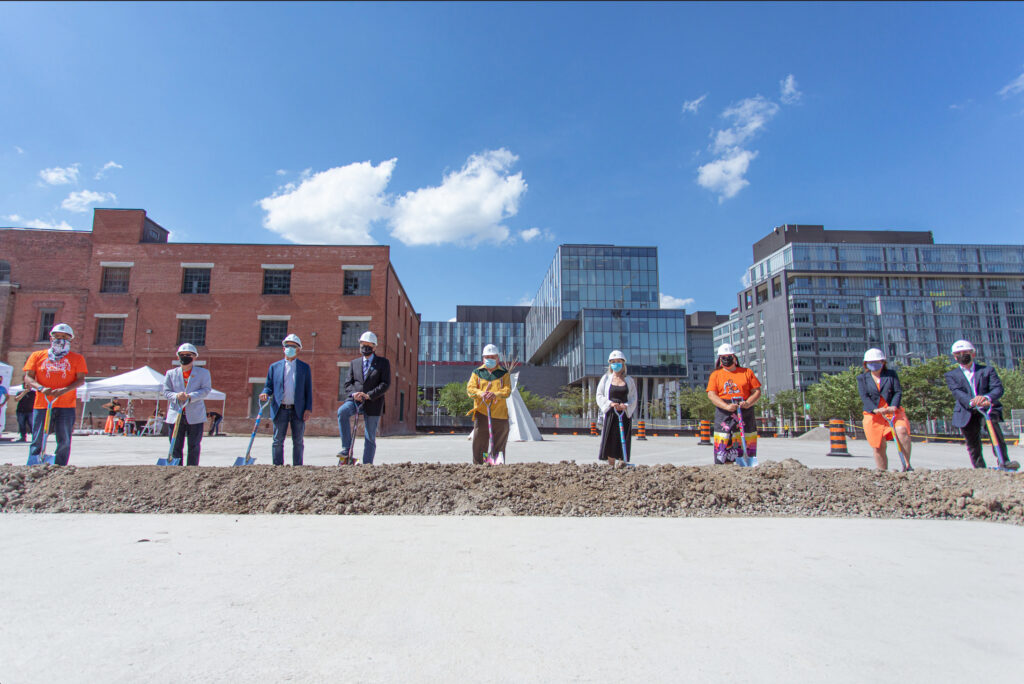
The Indigenous community in Toronto celebrated the ground breaking of a new Indigenous Hub in the city. The new Hub will help meet critical health care, spiritual, employment, training and family support needs for a community traumatically impacted by colonization, the residential school system and the ’60s Scoop’.
More than 700 virtually attended the live streamed celebration on National Indigenous Peoples Day and the Summer Solstice. The ceremony at the building site featured a pipe ceremony conducted by Cree Traditional Healer Pete Keshane.
The Hub is set up to be one of the first mixed-use, purpose-built Indigenous Hubs in the country and the first in Ontario, the milestone was celebrated with a socially distanced ground breaking event and featured First Nations drummers Young Creek and four fancy shawl dancers, reflecting the star blanket shawl-inspired design of the new home for Anishnawbe Health Toronto on the Hub.
“Today’s ground breaking is a major milestone, years in the making. The site will be a gathering place for the Indigenous people from across Turtle Island and a home to support the reclamation of culture and identity,” said Joe Hester, executive director of AHT. “In fact, this project will advance on many fronts including the restoration of traditional medicines and green space to this block that has an industrial past; implementing architectural guidelines for Indigenous design developed for this project; and to land ownership and lease agreements with development partners that will guide and support the Hub forward for seven generations and more.”
In 2015, as a legacy of the Pan Am/Parapan AM Games, the Province of Ontario transferred the land to Anishnawbe Health Toronto. AHT then partnered with Dream, Dream Impact Trust, Kilmer Group and Tricon Residential to co-develop the site for residential and retail uses.
The ground breaking, hosted by Andre Morriseau, chair of Anishnawbe Health Foundation, also included remarks from Marian Jacko, president of AHT; Krystal Abotossaway, president of Miziwe Biik; pre-recorded remarks from Chief R. Stacey Laforme of Mississaugas of the Credit First Nation; Mayor John Tory of the City of Toronto; Parliamentary Assistant MPP Robin Martin with pre-recorded remarks from Ontario Health Minister Christine Elliott; Ken Tanenbaum, vice-chair of Kilmer Group; and Stephen Diamond of Waterfront Toronto. At the end of the ceremony, the partners broke ground with 10 unique shovels designed and painted by five Indigenous artists.
The four-storey, 45,000 square-foot Anishnawbe Health Toronto Community Health Centre will offer holistic health programs and services that integrate Indigenous and Western approaches. A majority of the construction of the Health Centre will be funded by the Ministry of Health with the rest being funded by community support from donors through Anishnawbe Health Foundation.
Neighbouring the health centre is the Miziwe Biik Training Institute, which will serve as the employment and training partner. The new building will offer a hands-on carpentry workshop, tutoring classrooms, a business incubator and other multi-purpose training spaces for programming and gatherings, as well as a childcare and family centre. The Institute will enable Miziwe Biik to double its physical space, helping to support 700 to 1,000 Indigenous people secure new jobs annually.
The City of Toronto has contributed $7.8 million towards the creation of a new early learning and childcare centre for 49 children as well as a new Indigenous EarlyON Child and Family Centre, which will be located in the Miziwe Biik Training Institute. These centres will offer programs for children and families that will support and celebrate Indigenous knowledge, history and values.
“This is a time of pain and hurt in this world and a reminder of just how much work there is in front of us. But moments in time and adversity like this can turn a nation onto a good path. And it is time for that good path,” said Chief R. Stacey Laforme of Mississaugas of the Credit First Nation. “Seeing collaborations like this Hub, where all walks of life come together to make a dream into a reality, is very much in keeping with our traditional values. It is an example of a good path, and it gives us hope for the future.”








